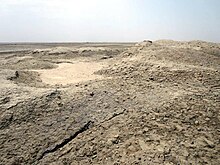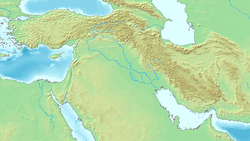Tell al-'Ubaid
العبيد | |
 | |
| Location | Dhi Qar Governorate, Iraq |
|---|---|
| Region | Lower Mesopotamia |
| Coordinates | 30°58′12″N 46°1′32″E / 30.97000°N 46.02556°E |
| Type | tell, type site |
| Length | 350 metre |
| Width | 250 metre |
| Height | 2 metre |
| History | |
| Periods | Early Dynastic period, Ubaid period, Jemdet Nasr period, Ur III period |
| Site notes | |
| Excavation dates | 1919, 1923-1924, 1937 |
| Archaeologists | Henry Hall, Leonard Woolley, Pinhas Pierre Delougaz, Seton Lloyd |
Tell al-'Ubaid (Arabic: العبيد) also (Tall al-'Ubaid) is a low, relatively small ancient Near Eastern archaeological site about six kilometers west of the site of ancient Ur in southern Iraq's Dhi Qar Governorate. Today, Tell al-'Ubaid lies 250 kilometers from the Persian Gulf, but the shoreline lay much closer to the site during the Ubaid and Early Dynastic periods. Most of the remains are from the Chalcolithic Ubaid period, for which Tell al-'Ubaid is the type site, with an Early Dynastic temple and cemetery at the highest point. It was a cult center for the goddess Ninhursag.[1] An inscription found on a foundation tablet (BM 116982) in 1919 and on a copper strip in 1923 read "For Nin-hursag: A'annepada, king of Ur, son of Mesannepada, king of Ur, built the temple for Ninhursag".[2]
Its ancient name is unknown but Nutur (alt Enutur) has been proposed, mainly based on the 20th year name of Ur III Empire ruler Shulgi (c. 2094–2046 BC) "Year: Ninḫursaga of Nutur was brought into her temple".[3]
Archaeology
[edit]The site was first worked by Henry Hall of the British Museum in 1919. Hall focused on the area which turned out to be the temple of Ninḫursaĝ, a 50 meter long and 7 meter high outcrop on the northern edge of the mound.[4] He found an Early Dynastic III stone statue of Kurlil.[5] Later, C. L. Woolley excavated there in 1923 and 1924,[6] followed by Seton Lloyd and Pinhas Delougaz in 1937, the latter working for the Oriental Institute of the University of Chicago.[7][8]
In 2008 the site was surveyed as part on an investigation of war-time damage to archaeological sites in Iraq by an Iraqi-British team. The team reported extensive damage as a result of "military installations when it was established as an Iraqi command post". This damage included a 4 meter square and 1.5 meter deep pit on the summit of the mound, 10 vehicle bays built around the mound base, and numerous hollows and pits on and around the mound. There was no sign of looting.[9]
Tell al-'Ubaid and its environment
[edit]The tell, or settlement mound, is an oblong measuring approximately 500 by 300 metres (1,640 ft × 980 ft) on a roughly north-south axis. It extends about 2 metres (6 ft 7 in) above the current surface. Finds included a copper framed frieze of limestone birds set in a black shale background.[10] The temple was also worked on in the Ur III period.[11][12] A cemetery was also found with 96 graves, mostly from the Early Dynastic Period.[13]
Occupation history
[edit]The lower level of the site featured large amounts of Ubaid pottery and associated kilns. Evidence for Ubaid period pottery manufacture has also been observed on the surface of the site. [11] The site also yielded a cemetery and some finds from the Jemdet Nasr period. The temple of Ninhursag at the summit was on a cleared oval similar to that at Khafajah. The wall surrounding the temple was built by Shulgi of the Ur III Empire.
Gallery
[edit]-
Stone statue of Kurlil, Early Dynastic III, 2500 BC Tell Al-'Ubaid
-
Parts of mosaic columns from the entrance to the Temple of Ninhursag at Tell al-'Ubaid, Iraq, 2800-2600 BCE. Iraq Museum
-
Recumbent cow, part of a frieze once decorated the facade of the Temple of Ninhursag at Tell al-'Ubaid, Iraq, 2800-2600 BCE. Iraq Museum
-
Sumerian scene, milking cows and making dairy products. From the facade of the Temple of Ninhursag at Tell al-'Ubaid, Iraq, 2800-2600 BCE. Iraq Museum
-
A'annepada foundation tablet (BM 116982). British Museum
See also
[edit]References
[edit]- ^ Frayne, Douglas R. and Stuckey, Johanna H., "N", A Handbook of Gods and Goddesses of the Ancient Near East: Three Thousand Deities of Anatolia, Syria, Israel, Sumer, Babylonia, Assyria, and Elam, University Park, USA: Penn State University Press, pp. 219-287, 2021
- ^ Gadd, C. J., "A New Copy of A-Anni-Padda's Inscription from Al-'Ubaid", The British Museum Quarterly, pp. 107-108, 1930
- ^ [1]Firth, Richard. 2013. “Notes on Year Names of the Early Ur III Period: Šulgi 20-30.” Cuneiform Digital Library Journal 2013
- ^ H. R. Hall, Season's Work at Ur; Al-'Ubaid, Abu Shahrain (Eridu), and Elsewhere; Being an Unofficial Account of the British Museum Archaeological Mission to Babylonia, 1919, Methuen, 1930
- ^ Reade, Julian. "Early monuments in Gulf stone at the British Museum, with observations on some Gudea statues and the location of Agade" , vol. 92, no. 2, 2002, pp. 258-295
- ^ Hall, H. R.; Woolley, C. L. (1927). UR Excavations Volume I Al-'Ubaid. Oxford University Press.
- ^ Delougaz, P. (1938). "A Short Investigation of the Temple at Al-'Ubaid". Iraq. 5: 1–11. doi:10.2307/4241617. JSTOR 4241617. S2CID 130499268.
- ^ Seton Lloyd, Ur-al 'Ubaid, 'Uqair and Eridu. An Interpretation of Some Evidence from the Flood-Pit, Iraq, ol. 22, Ur in Retrospect. In Memory of Sir C. Leonard Woolley, pp. 23-31, (Spring - Autumn, 1960)
- ^ Curtis, John, et al., "An Assessment of Archaeological Sites in June 2008: An Iraqi-British Project", Iraq, vol. 70, pp. 215–37, 2008
- ^ [2]Paszke, Marcin Z., "Bird species diversity in 3rd millennium BC Mesopotamia: The case of the Al-Ubaid bird frieze from the Temple of Nin", Bioarchaeology of the Near East 15, pp. 25-54, 2021
- ^ a b Moore, A.M.T. (2002). "Pottery Kiln Sites at al 'Ubaid and Eridu". Iraq. 64: 69–77. doi:10.2307/4200519. JSTOR 4200519.
- ^ Clayden, Tim, "Kassite Housing at Ur: The Dates of the EM, YC, XNCF, AH and KPS Houses", Iraq, vol. 76, pp. 19–64, 2014
- ^ Harriet P. Martin, The Early Dynastic Cemetery at al-'Ubaid, a Re-Evaluation, Iraq, vol. 44, no. 2, pp. 145-185, 1982
Further reading
[edit]- Korbel, Günther, "Zur zeitlichen Gliederung des Al-Ubaid-Friedhofs in Ur", BaM, vol. 14, pp. 7-14, 1983
- [3]Mansor, Mohammed Abdulridha, and Jabbar Madhy Rashid, "Evaluation of natural radioactivity for building materials samples used in Tall Al Ubaid Archaeologist in Dhi-Qar governorate-Iraq", Samarra Journal of Pure and Applied Science 2.1, pp. 53-66, 2020







